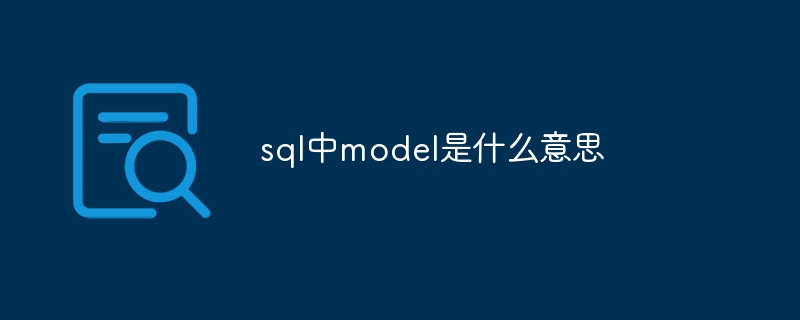What does model mean in sql
Model in SQL is an abstract concept used to represent real-world entities through two main types: relational model and object-relational model, which provides data abstraction, integrity, query and retrieval functions. Consider data type, scalability, and performance when choosing a model.

Model in SQL
In SQL, the word "Model" is usually used to describe data storage and Management abstract concept. It is a conceptual framework for representing entities in the real world and the relationships between them.
Types of Model
There are two main types of Model in SQL:
- Relational model: Data is organized into tables, where each row represents an entity and each column represents an attribute.
- Object Relational Model (ORM): Represents data as objects that can be mapped to tables and columns in a relational database.
Uses of Model
Model has the following main uses in SQL:
- Data abstraction: Hides the complexity of the underlying data storage, making it easier to operate and understand the data.
- Data integrity: Ensure data accuracy and consistency by defining constraints and rules.
- Data query and retrieval: Provides a structured framework for querying, retrieving and modifying data.
Select Model
When selecting a Model in SQL, the following factors should be considered:
- Data type: Consider the nature of the data type (e.g., structured, semi-structured, or unstructured).
- Scalability: Consider the scalability of the Model as the amount and complexity of data increases.
- Performance: Evaluate the performance impact of Model on query, insert and update operations.
By carefully considering these factors, the most appropriate Model can be selected for a specific data set and application.
The above is the detailed content of What does model mean in sql. For more information, please follow other related articles on the PHP Chinese website!

Hot AI Tools

Undresser.AI Undress
AI-powered app for creating realistic nude photos

AI Clothes Remover
Online AI tool for removing clothes from photos.

Undress AI Tool
Undress images for free

Clothoff.io
AI clothes remover

AI Hentai Generator
Generate AI Hentai for free.

Hot Article

Hot Tools

Notepad++7.3.1
Easy-to-use and free code editor

SublimeText3 Chinese version
Chinese version, very easy to use

Zend Studio 13.0.1
Powerful PHP integrated development environment

Dreamweaver CS6
Visual web development tools

SublimeText3 Mac version
God-level code editing software (SublimeText3)

Hot Topics
 1377
1377
 52
52
 How do I comply with data privacy regulations (GDPR, CCPA) using SQL?
Mar 18, 2025 am 11:22 AM
How do I comply with data privacy regulations (GDPR, CCPA) using SQL?
Mar 18, 2025 am 11:22 AM
Article discusses using SQL for GDPR and CCPA compliance, focusing on data anonymization, access requests, and automatic deletion of outdated data.(159 characters)
 How do I secure my SQL database against common vulnerabilities like SQL injection?
Mar 18, 2025 am 11:18 AM
How do I secure my SQL database against common vulnerabilities like SQL injection?
Mar 18, 2025 am 11:18 AM
The article discusses securing SQL databases against vulnerabilities like SQL injection, emphasizing prepared statements, input validation, and regular updates.
 How do I implement data partitioning in SQL for performance and scalability?
Mar 18, 2025 am 11:14 AM
How do I implement data partitioning in SQL for performance and scalability?
Mar 18, 2025 am 11:14 AM
Article discusses implementing data partitioning in SQL for better performance and scalability, detailing methods, best practices, and monitoring tools.
 How to use sql datetime
Apr 09, 2025 pm 06:09 PM
How to use sql datetime
Apr 09, 2025 pm 06:09 PM
The DATETIME data type is used to store high-precision date and time information, ranging from 0001-01-01 00:00:00 to 9999-12-31 23:59:59.99999999, and the syntax is DATETIME(precision), where precision specifies the accuracy after the decimal point (0-7), and the default is 3. It supports sorting, calculation, and time zone conversion functions, but needs to be aware of potential issues when converting precision, range and time zones.
 How do I use SQL for data warehousing and business intelligence?
Mar 18, 2025 am 11:16 AM
How do I use SQL for data warehousing and business intelligence?
Mar 18, 2025 am 11:16 AM
The article discusses using SQL for data warehousing and business intelligence, focusing on ETL processes, data modeling, and query optimization. It also covers BI report creation and tool integration.
 How to use sql if statement
Apr 09, 2025 pm 06:12 PM
How to use sql if statement
Apr 09, 2025 pm 06:12 PM
SQL IF statements are used to conditionally execute SQL statements, with the syntax as: IF (condition) THEN {statement} ELSE {statement} END IF;. The condition can be any valid SQL expression, and if the condition is true, execute the THEN clause; if the condition is false, execute the ELSE clause. IF statements can be nested, allowing for more complex conditional checks.
 How do I handle concurrency issues in SQL?
Mar 18, 2025 am 11:12 AM
How do I handle concurrency issues in SQL?
Mar 18, 2025 am 11:12 AM
The article discusses strategies for handling concurrency issues in SQL, including transactions, isolation levels, locking mechanisms, and best practices for managing concurrent transactions to ensure data integrity and performance.
 How do I use stored procedures and functions in SQL?
Mar 18, 2025 am 11:09 AM
How do I use stored procedures and functions in SQL?
Mar 18, 2025 am 11:09 AM
Article discusses use and benefits of stored procedures and functions in SQL, including performance optimization and differences between them.




